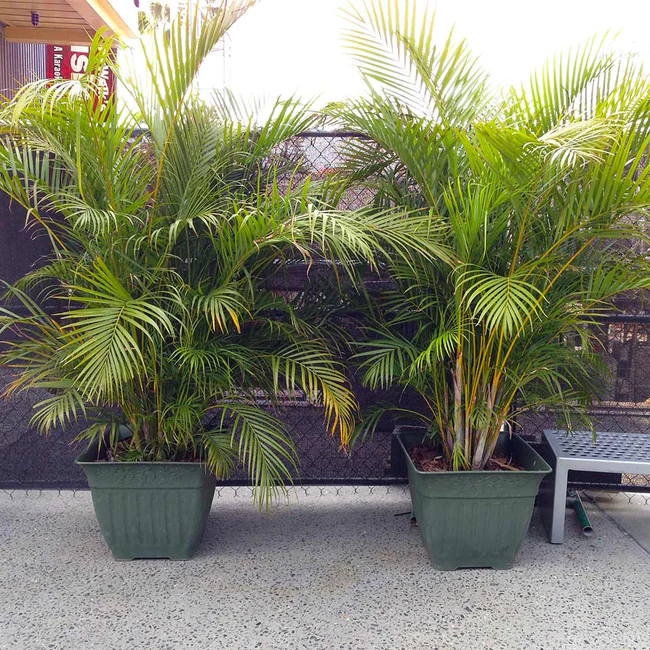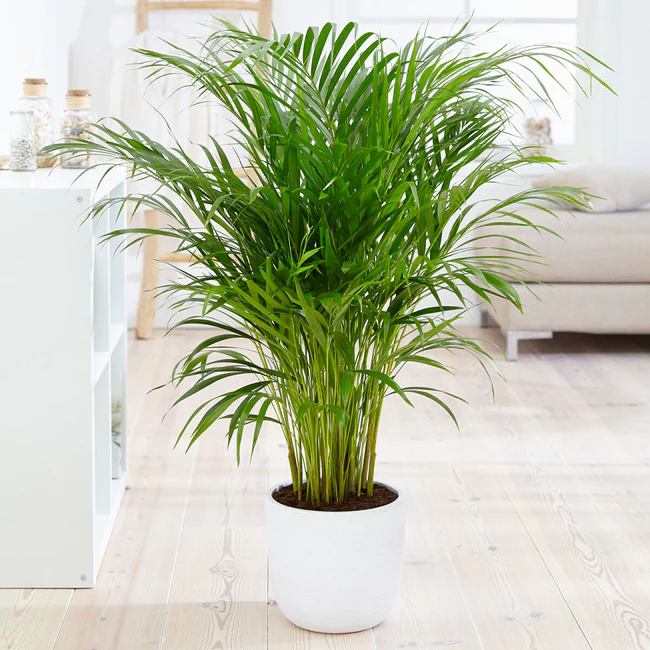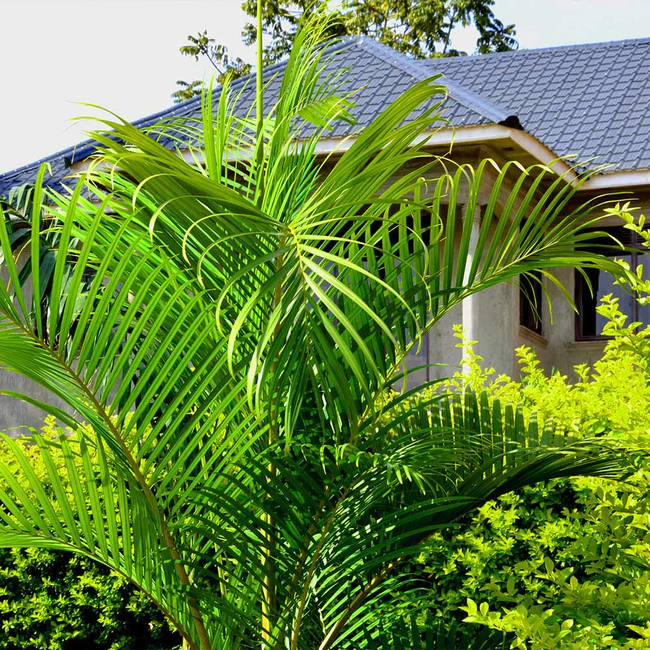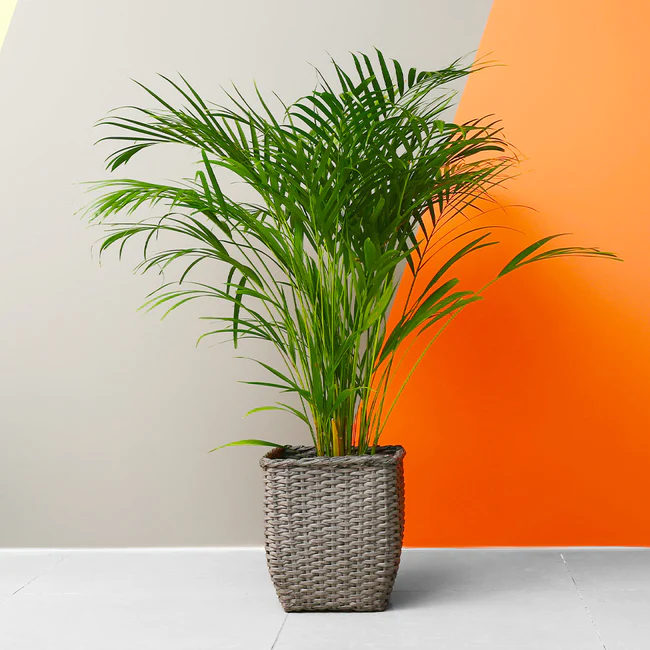This post contains affiliate links. If you buy something from one of our links we may earn a commission. Thanks

Learn all about Areca Palm care indoors! Discover the best growing conditions, watering and fertilizing tips, and how to prevent pests and diseases.
Areca Palm Care Indoors requires a warm, high-humidity environment with bright, indirect light. Water it once a week, ensuring the soil is not waterlogged. Fertilize once a month with a balanced liquid fertilizer during the growing season.
To keep pests and diseases at bay, regularly check for signs of infestation and use natural remedies like neem oil or insecticidal soap as needed. Propagation can be done by dividing the plant or planting seeds.
Welcome to the world of indoor gardening! If you’re looking for a way to add some life and color to your home, an Areca Palm might be just what you need.
Not only is this tropical beauty pleasing to the eye, but it also has several health benefits, including air purification and mood enhancement.
Areca Palm Quick Facts
| Mature Height: | 4-5 ft Indoors 15-30 ft Outdoors |
| Mature Width: | 3-5 ft Indoors 5-15 ft Outdoors |
| Sunlight: | Indirect Light |
| Growth Rate: | Slow |
| Botanical Name: | Dypsis lutescens |
| Grows Well In Zones: | 4-11 patio / 10-11 outdoors |
Buy your Areca Palm here on Amazon
Introduction to Areca Palm Care Indoors

Areca palm plants are beautiful tropical plants that can bring a touch of the exotic to any indoor space.
However, like any other indoor plant, proper care is essential to keep it healthy and thriving.
In this blog post, we’ll be discussing everything you need to know about Areca Palm care indoors, from ideal growing conditions to common pests and diseases to propagation.
So, whether you’re an experienced indoor gardener or just starting, this guide has what you need to know.
So sit back, relax, and let’s dive into the world of caring for Areca Palms indoors!
Benefits of Having Plants in the House
Plants have been shown to have numerous health benefits, both physical and psychological.
One of the most significant benefits of having plants in the house is air purification.
Areca palms, in particular, are known to remove harmful pollutants from the air, making it cleaner and healthier to breathe.
Additionally, plants have been shown to improve mood, reduce stress levels, and increase productivity, making them a great addition to any indoor space.
Whether you’re looking to improve your physical health or mental well-being, adding an Areca Palm to your indoor garden can help.
What Is An Areca Palm?
Areca palms, also known as Dypsis lutescens, are beautiful tropical, attractive palms that are native to Madagascar.
They are also called the butterfly palm, golden cane palm, or yellow palm.
They are known for their elegant, feathery fronds and slender, bamboo-like trunks that can reach up to 20 feet in height.
Not to be confused with Areca, a genus of palms.
Dypsis lutescens, also known as golden cane palm, areca palm, yellow palm, butterfly palm, or bamboo palm, is a species of flowering plant in the family Arecaceae, native to Madagascar https://en.wikipedia.org/wiki/Dypsis_lutescens
These plants are a popular choice for indoor gardening due to their adaptability and ability to thrive in low-light conditions.
In this section, we’ll take a closer look at the physical characteristics and origin of Areca Palms, so you can get to know this tropical beauty a little better.
General Overview of Areca Palms

Areca Palms are also known by their scientific name, Dypsis lutescens, and are a species of palm trees native to Madagascar.
They belong to the family Arecaceae, which includes other well-known palm species such as coconut and date palms.
In the wild, Areca Palms can grow up to 30 feet tall, but they can be successfully grown as an indoor palm as well, as long as their environment is adequately cared for.
Physical Characteristics of Areca Palms
Areca Palms are known for their elegant appearance, with slender, bamboo-like trunks that can grow up to six inches in diameter.
The fronds of an Areca Palm are feathery, pinnate leaves that can grow up to six feet long, and are bright green in color.
These fronds arch gracefully over the top of the plant, giving it an exotic, tropical feel.
The overall shape of the plant is symmetrical, making it an excellent choice for adding balance and structure to any indoor space.
When providing Areca Palm care indoors, it’s important to keep in mind their natural habitat and replicate the growing conditions as closely as possible to help ensure their healthy growth.
Indoor Growing Conditions In A Nutshell
• Areca Palms thrive in warm, high-humidity environments with bright, indirect light.
• The ideal temperature range for Areca Palms is between 65°F to 75°F.
• They prefer soil that is well-draining, rich in organic matter, and slightly acidic.
In terms of lighting, Areca Palms need bright, indirect light to thrive.
• Direct sunlight can scorch the leaves, so it’s important to avoid placing them in direct sunlight.
• Additionally, Areca Palms need to be watered regularly, but overwatering can be harmful to their growth.
• It’s important to keep the soil evenly moist but not waterlogged.

Mimicking the Natural Habitat of Areca Palms
To mimic the natural habitat of Areca Palms as much as possible, it’s important to keep the growing conditions consistent with those found in their native environment.
This includes providing warm, humid conditions and regular, consistent watering. Additionally, Areca Palms benefit from occasional misting to help increase the humidity around the plant.
If the air in your home is dry, you can also consider using a humidifier to help keep the humidity levels up.
By providing the ideal growing conditions for your Areca Palms, you can help ensure they thrive and stay healthy.
Indoor Growing Conditions
When it comes to indoor gardening, providing the right growing conditions is essential for keeping your plants healthy and thriving.
Areca Palms are no exception, and in this section, we’ll take a closer look at the ideal growing conditions for these tropical beauties.
From the amount of light they need to the type of soil they prefer, we’ll cover everything you need to know to create the perfect environment for your Areca Palms to flourish.
Whether you’re a seasoned indoor gardener or just starting, understanding the proper growing conditions is the first step towards successfully caring for your plants.
Watering and Fertilizing
Areca Palms require proper watering and fertilizing to maintain their health and vitality.
In this section, we’ll take a closer look at how to water and fertilize your Areca Palms, including the type of soil they prefer, how often to water them, and what kind of fertilizer to use.
By understanding the watering and fertilizing needs of your Areca Palms, you can help ensure they thrive and remain healthy for years to come.
Watering Needs of Areca Palms
How often to water Areca Palms:
Areca Palms like to be kept consistently moist, but not waterlogged.
The frequency of watering depends on factors such as the size of the plant, the pot size, and the humidity of the environment.
In general, it’s recommended to water Areca Palms once a week. However, you should always check the soil moisture level before watering.
Areca palm trees require moist soil but they must have good drainage too. It is important to use a pot with drainage holes to let any excess water drain off.
Signs that your Areca Palms are under or overwatered:
Underwatered Areca Palms will have dry, yellowing fronds and may droop.
Overwatered plants may have yellow or brown fronds that are soft or mushy. The soil may also be waterlogged, and the roots may appear brown or black and mushy.
How much water to give your Areca Palms:
The amount of water to give your Areca Palms depends on the size of the pot, the size of the plant, and the humidity of the environment.
A general rule of thumb is to water until water starts to drain out the bottom of the pot, and then stop. This ensures that the entire root system is moistened.
Then don’t water again until the top inch of soil is dry to the touch.
Tap Water
Tap water can contain chemicals that can cause brown leaves so it is best to use distilled water for your palm plant. RO water or rainwater also work well or you can add a filter to your tap.
If you see brown spots or brown leaf tips your tap water may be responsible.

Fertilizing Areca Palms
Types of fertilizer to use:
The Areca Palm is a heavy feeder and will benefit from a balanced liquid fertilizer, such as a 10-10-10 or 20-20-20.
These fertilizers contain equal amounts of nitrogen, phosphorus, and potassium. You can also use a slow-release fertilizer, which slowly releases nutrients over time.
How to apply fertilizer:
You should fertilize Areca Palms once a month during the growing season, which is typically from spring to fall.
Use a diluted solution of the fertilizer and water, following the package instructions.
Apply the solution to the soil around the base of the plant, making sure not to get any on the leaves.
It is also a good idea to start with half-strength fertilizer and see how your plant reacts. You can always add more later but adding too much is harder to correct.
When to fertilize Areca Palms:
You should fertilize Areca Palms once a month during the growing season, which is typically from spring to fall.
During the winter, when growth slows down, you can reduce or stop fertilizing altogether.
Slow Release Fertilizer Spikes
I like to use fertilizer spikes for my palm and citrus trees. They take all the guesswork out of fertilizing.
Here is what I recommend for  fertilizing your Areca palm.
fertilizing your Areca palm.
I recommend using Jobes Organics fertilizer spikes.
They are easy to use and last for 2-3 months.
They are designed for container-grown citrus but work great for palm trees too.
Using 2 spikes for a 12-inch pot or 3 for an 18-inch pot takes the guesswork out of fertilizing.
They provide a 3-5-5 fertilizer blend along with micronutrients and beneficial bacteria.
Common Pests and Diseases
Areca Palms are generally low-maintenance plants, but like any other houseplant, they are susceptible to pests and diseases.
In this section, we will discuss some of the most common pests and diseases that can affect Areca Palms, and provide tips on how to identify and treat them.
By learning about these potential problems and how to prevent and treat them, you can ensure that your Areca Palms stay healthy and vibrant.
Pests and diseases that can affect Areca Palms, and how to identify and treat them:
A. Pests
Spider mites: These tiny pests can cause visible damage to the leaves of Areca Palms, such as discoloration and stippling.
You can identify spider mites by looking for small, web-like structures on the undersides of leaves.
To treat spider mites, you can use insecticidal soap or neem oil.
Mealybugs: These soft-bodied pests can cause yellowing and wilting of the leaves of Areca Palms.
You can identify mealybugs by looking for small, cotton-like masses on the leaves and stems.
To treat mealybugs, you can use a cotton swab soaked in rubbing alcohol to remove the pests from the plant. You can also use insecticidal soap or neem oil.
Scale insects: These insects attach themselves to the stems and leaves of Areca Palms and suck the sap from the plant.
You can identify scale insects by looking for small, round bumps on the leaves and stems.
To treat scale insects, you can use a cotton swab soaked in rubbing alcohol to remove the pests from the plant. You can also use insecticidal soap or neem oil.
Diseases
Fungal infections: Areca Palms are susceptible to several types of fungal infections, such as root rot and leaf spot.
You can identify fungal infections by looking for discolored or mushy leaves and stems.
To treat fungal infections, you can improve the drainage of the soil, prune affected leaves and stems, and apply a fungicide.
Nutrient deficiencies: Areca Palms can also suffer from nutrient deficiencies, such as yellowing leaves caused by a lack of micronutrients like iron or calcium, and magnesium.
It can be difficult to identify nutrient deficiencies but look for yellow or brown discoloration on the leaves.
The best way to deal with nutrient deficiencies is to always fertilize the plant with a balanced fertilizer that contains them.
By keeping an eye out for these common pests and diseases, and taking steps to prevent and treat them, you can help ensure that your Areca Palms remain healthy and beautiful.

Propagation
If you’re a plant lover, the idea of propagating your own plants can be both exciting and rewarding.
Propagation is the process of growing new plants from existing ones, and it’s a great way to expand your plant collection or share your plants with others.
If you’re a fan of Areca Palms and want to grow more of them, propagation is a great option.
Propagation is the process of creating new plants from existing ones, and it can be a fun and rewarding way to expand your indoor garden.
In this section, we will discuss some basic methods for propagating Areca Palms, including dividing the plant and planting seeds.
With a little patience and care, you can easily propagate Areca Palms and enjoy even more of their lush, tropical foliage in your home.
Steps involved in dividing the plant or planting seeds
There are two main ways to propagate Areca Palms: by dividing the plant or by planting seeds. Here’s a brief overview of each method:
Dividing the plant:
This method involves removing the Areca Palm from its container and dividing it into smaller sections, each with its own root system.
To do this, gently remove the plant from its pot and shake off any excess soil. Carefully separate the individual stems from the parent plant.
Use a sharp knife making sure to keep as much of the root system intact as possible along with some canes.
Repot each division into its own new pot, using fresh soil and watering thoroughly to remove any air pockets.
Planting seeds:
Propagating Areca Palms from seed can take a bit longer than dividing the plant, but it can be a fun and rewarding process.
Start by selecting a mature Areca Palm that has produced flowers and seeds.
Collect the seeds and plant them in a well-draining potting mix, covering them lightly with soil. Don’t want to wait?
You can buy Areca palm seeds here on Amazon.
Keep the soil moist but not soggy, and provide plenty of warmth and light.
In a few weeks, you should see the first signs of germination, and over time the seedlings will grow into mature Areca Palms.
FAQs about Areca Palm Care Indoors:
Navigating the care of an indoor Areca Palm may raise questions, from understanding its watering needs to ensuring it thrives.
Here are some Frequently Asked Questions (FAQs) to guide you through the basic care routine of your Areca Palm, helping to foster a healthy, vibrant plant.
Q. What is the ideal temperature range for Areca Palms indoors?
A. The ideal temperature range for Areca Palms is between 65°F to 75°F.
Q. How often should I water my Areca Palm?
A. It’s recommended to water Areca Palms once a week, but always check the soil moisture before watering. Ensure the soil is moist, not waterlogged.
Q. What type of fertilizer is best for Areca Palms?
A. Use a balanced liquid fertilizer, such as a 10-10-10 or 20-20-20, or slow-release fertilizer spikes, to provide essential nutrients to your Areca Palm.
Q. How can I propagate my Areca Palm?
A. Propagation can be done by dividing the plant into smaller sections, each with its own root system, or by planting seeds from a mature Areca Palm.
Areca Palm Care Indoors Final Thoughts
Areca Palms are beautiful, tropical plants that can thrive indoors with the right care.
In this blog post, we’ve covered the basics of caring for these plants, including their ideal growing conditions, watering and fertilizing needs, common pests and diseases, and how to propagate them.
By following these tips, you can enjoy the lush, feathery fronds of an Areca Palm in your own home.
Not only are these plants aesthetically pleasing, but they also offer several health benefits such as purifying the air and improving mood.
So, why not try growing an Areca Palm indoors today and reap the benefits of having a healthy, green addition to your home?
Buy your Areca Palm here on Amazon
Read more: Indoor Palm Tree Care: 11 Powerful Tips Complete Guide For Beginners









